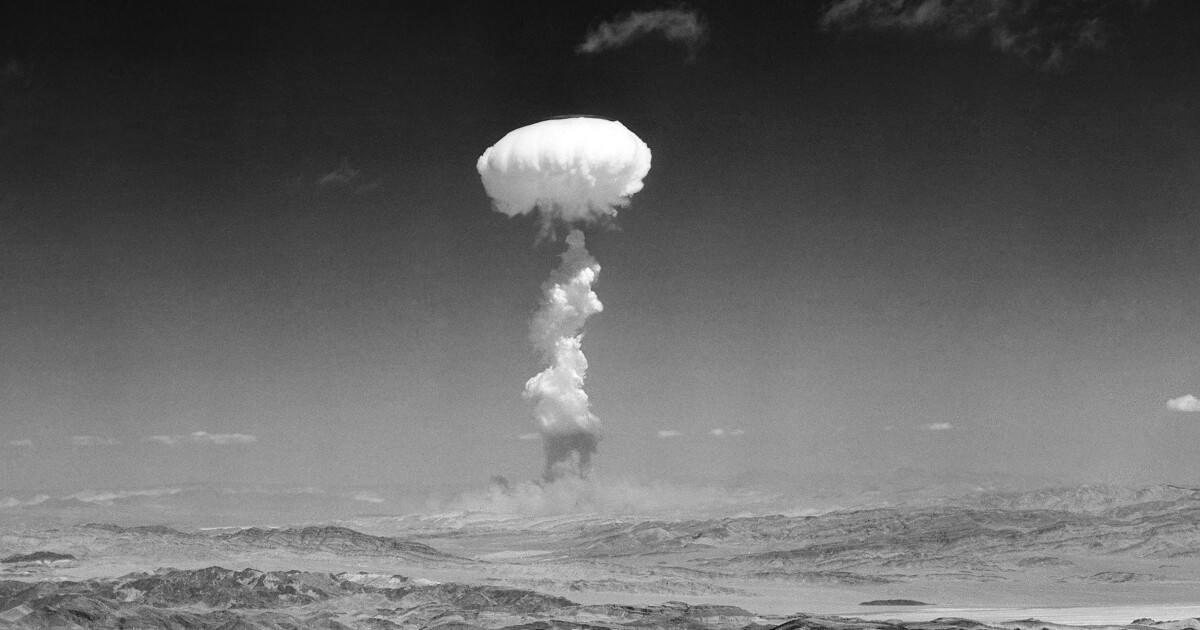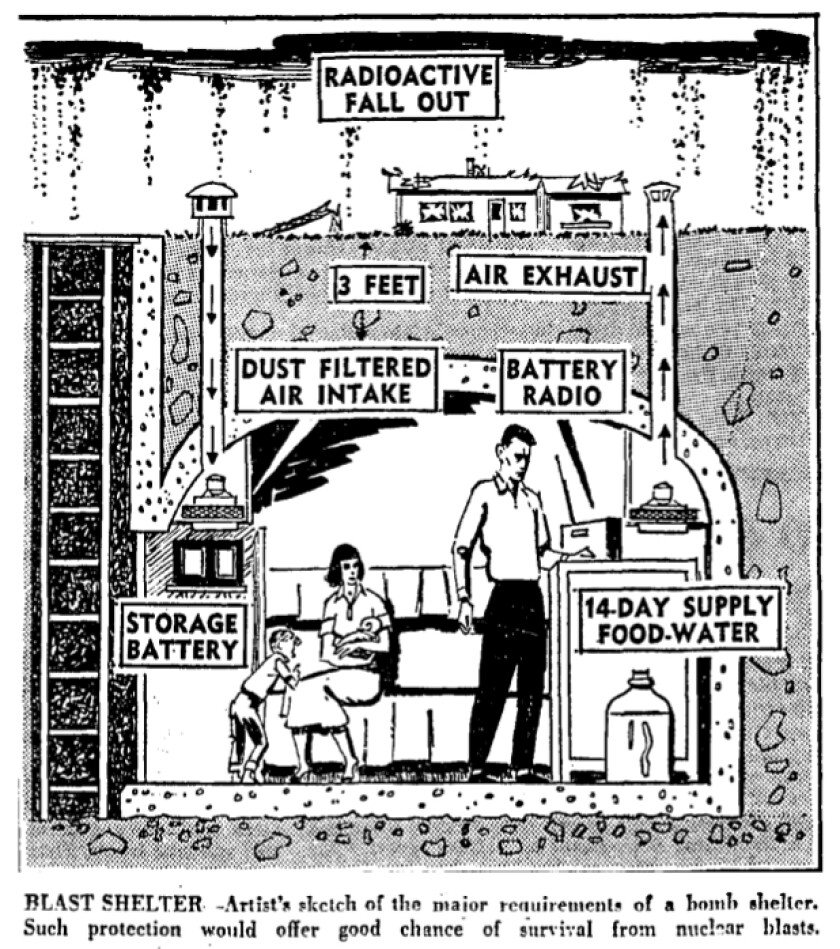
You understand Angelenos and actual property: If any individual’s promoting it, we’ll purchase it, even though it’s underground.
Lengthy earlier than “da bomb,” there was once “The Bomb.” The primary is a now-obsolete descriptor for “cool.” The second one is an actual WMD, now not remotely cool, and now not remotely with reference to out of date.
On account of the capital-b Bomb, Southern California, ever the groundbreaker, as soon as had a positive obsession with that quirky Chilly Struggle amenity: the yard bomb safe haven, a thermonuclear model of that time-share you by no means finally end up the use of.
Nowadays, because the Bulletin of the Atomic Scientists units the fingers of its doomsday clock to an ominous 100 seconds to a nuclear nighttime, perhaps the ones hidey-holes are beginning to glance lovely excellent, despite the fact that fact to inform, they had been most certainly slightly extra performative Chilly Struggle theatrics than precise coverage. As a Los Angeles musician of word as soon as famous, “no person right here will get out alive,” or a minimum of unscathed.
Anyhoo, issues gave the impression concurrently scarier and extra chipper within the ’50s and ’60s when it got here to nuclear survivability-think. From the top of scorching Global Struggle II throughout the Cuban Missile Disaster and till nearly the defrosting of the Chilly Struggle, federal and native governments, together with any collection of doomsday marketers, promoted the bomb/fallout shelters as one thing no circle of relatives must be with out.
“The house fallout safe haven,” opined Joseph J. Micciche, L.A.’s civil protection director, “is the one way of survival within the match of nuclear assault.” As past due as 1982, President Reagan’s deputy undersecretary of protection for analysis and engineering, Thomas Ok. Jones, a stalwart believer in civil protection techniques, was once totally trustworthy when he mentioned, “If there are sufficient shovels to move round, everyone’s going to make it.”
To Commie nuke-planners, Southern California — which had invested for many years in aviation, protection and aerospace — wore a large goal. That can have sped up safe haven anxieties.
In Might 1960, a Los Angeles corporate switched from making trampolines to creating steel fallout shelters, sending salesmen door to door to hawk the $1,500 prefab steel type, with out, after all, atmosphere off little bombs because the touring salesman’s usual home-test demonstration.
A Pomona corporate bought the Fox Hollow Safe haven, an igloo-shaped safe haven put in in at some point and warranted to resist an atomic blast 3 miles away — safe, most likely, within the sure bet that disappointed consumers would now not be round to call for a reimbursement at the guaranty.
The famend architect Wallace Neff constructed a bubble-shaped underground safe haven for his famend “Bubble Area” in Pasadena, the place one post-Chilly Struggle proprietor would retreat for primal-scream remedy and guitar jam periods.
In Redondo Seashore in 1951, a contractor were given allows to construct two shelters: one at his own residence, with room sufficient for 6, and every other for a area he rented out.
A 1964 Covina property, the place some descendants of the founding father of the Singer stitching gadget corporate appreciated to summer season, gloried in a koi pond, an aviary and a 10-bed bomb safe haven.
In September 1961, up in Benedict Canyon, a circle of relatives guy constructed a “subterranean citadel” beside the swimming pool. It was once fitted out with radio, telephone, TV, and Geiger counter, and capacious sufficient for 15 other people to spend 30 days. The ones other people had been the mister and missus, their 3 small children, their 3 married kids and grandkids (if they may get there earlier than the hatch was once sealed), 4 servants, and a collie, a Pekingese and a miniature bulldog.
Past due within the Nineteen Sixties, the folks of Victorville introduced pickaxes and shovels to dig a capacious safe haven deep in an deserted mine shaft. They stocked it with clinical provides, meals and water for 3 weeks, a file participant, seeds, and greater than one thousand books. The native civil protection coordinator, William C. Melton, admitted that Victorville was once not really a chief bomb goal: “The one explanation why there would ever be a nuclear strike in Victorville is that if the enemy had been 100 miles off his mark.” There was once room for 1,100 other people, first come, first served. (A Fb web page for the Mojave Wasteland Cultural and Heritage Assn. notes that “vandals and thieves” quickly stole or smashed or set fireplace to on the subject of the entirety at the premises, and that “slightly a scar” stays to mark its position as a big step towards remaining the scary Strangelovian “mine shaft hole.”

A graphic that ran within the Los Angeles Instances in 1961 displays estimated injury if a nuclear weapon had been to strike within the center of L.A.
(Los Angeles Instances Archive)
In Monrovia, a civil engineer who had survived the London blitz constructed what he referred to as “a lifestyles area,” with a door of lead and laminated picket, and a small generator powered by way of a desk bound motorbike that doubled as workout for the shelter-bound. “A excellent, well-planned underground safe haven is a will have to for everybody at the moment.”
My fave could be a Fifties WeHo-adjacent property, again in the marketplace a few years in the past, that’s tricked out with what The Instances described as winding “indoor-outdoor lagoon” resulting in an underwater tunnel wherein one reaches the bomb safe haven — “a secret, sealed underground cave aerated with oxygen tanks.” In different phrases, you needed to swim to be stored.
Every was once constructed now not handiest with the religion that it could live to tell the tale an preliminary blast, however that sooner or later — days, weeks, or months — the sheltered may emerge to select up lifestyles such because it was once in a post-nuke international.
Relatively stupefyingly, The Instances published the addresses of those newly defensible dwellings. What neighbors would possibly now not believe banging on a safe haven door when the nuclear sirens sounded? Ministers spoke from their pulpits in regards to the ethics of bomb shelters: Used to be it ethical so as to add weapons to the provides of canned meals and bathroom paper? “The Twilight Zone” aired an episode in 1961 a couple of safe haven atmosphere neighbor towards neighbor because the missiles had been inbound.
An debatable bomb subculture introduced itself. Novelists Joyce Carol Oates and John Cheever constructed bomb shelters into their fiction. A Instances monetary recommendation columnist in 1961 tackled the query: Are fallout shelters excellent investments? (Like such columnists earlier than and after, the solution was once: It is dependent.) Marriage ceremony-shower visitors gift-wrapped imperishable bomb-shelter meals like beans and crackers. A newlywed pair in 1959 Florida did take a dare from a radio station and spent their two-week honeymoon underground, the place the radio station and her folks referred to as them up too repeatedly an afternoon. They emerged short of ice-cold water, baths, and steaks, and longing for their prize: a two-week honeymoon in Mexico. They remained married till a herbal dying, now not a nuclear one, did them phase 42 years later.

A 1961 L.A. Instances graphic depicts a fallout safe haven. Appears slightly tight for a circle of relatives of 4.
But Southern Californians nonetheless saved digging way more holes for swimming swimming pools than for shelters. In mid-1960, the Gallup ballot discovered that 71% of American citizens sought after shelters, all proper — however they sought after government-built and -run shelters. Greater than a 3rd had been focused on non-public shelters, as long as they value not more than $500, however part gave them a complete cross.
Los Angeles County was once then bearing in mind turning typhoon drains into bomb shelters, a mission code-named “Operation Giant Ditch.” The town of L.A. did finally end up designating greater than one thousand public fallout shelters, most commonly basements or inner rooms of presidency constructions, and it saved on its payroll full-time inspectors to ensure they had been all as much as snuff.
The final of those inspectors labored, by myself, a minimum of into the Seventies, with a confounding checklist that named the shelters alphabetically, now not geographically. His inspections discovered that the “no-expiration” safe haven crackers had became rancid and “tasted like hell,” and what narcotics hadn’t been stolen had been formally got rid of. The inventory of diarrhea drugs had settled right into a “thick, chalky glob” that wouldn’t pop out of the bottle.
In 1961, now not lengthy after President Kennedy admitted he’d been “savaged” by way of Soviet Premier Nikita Khrushchev at a summit, a Johns Hopkins psychiatry professor advised us to forestall being concerned — now not in regards to the bomb, however about bomb shelters. “We’re a really perfect other people for fads. Have in mind how the hula hoop swept the rustic? And the yo-yo? Smartly, at the moment it’s the article to do to speak about construction a fallout safe haven. Amongst my non-public acquaintances, alternatively, I do know only a few who’ve long past past the speaking and feature if truth be told constructed shelters.”
From time to time, certainly one of them nonetheless turns up in those portions. In 2013, a Wooded area Hills circle of relatives found out in its new domestic the proof of an previous circle of relatives: a well-stocked fallout safe haven constructed within the Nineteen Sixties, about 15 toes underground, by way of a self-taught nuclear engineer whose daughter had not too long ago bought the home and remembered the safe haven rather well.
Such unearthings came about steadily sufficient that Hollywood tweaked this right into a 1998 film referred to as “Blast From the Previous,” a couple of grown guy who had lived completely in a safe haven along with his folks, till he emerged into the modern day San Fernando Valley, a surprise sufficient for someone’s machine.
The shelters had been handiest part of the civil protection community. Inside of weeks of the 1941 Pearl Harbor assault, Los Angeles purchased rankings of air-raid sirens, some fashioned like rockets, some fashioned like trumpets, or birdhouses, and fastened them above fireplace stations, on phone poles, at Griffith Park observatory. The warbling sound supposed “assault drawing close,” the stable word “all transparent.”
Even again then, other people complained that they had been useless. The sound was once too faint, and too just like police or fireplace sirens, or automotive horns. The Instances groused in 1952 in regards to the “pipsqueak sirens … what we’d like are some in point of fact LOUD alarms that may make a particular noise and all however wake the lifeless.”
Someone who labored in downtown Los Angeles earlier than 1985 will needless to say at 10 o’clock within the morning, at the final Friday of the month, any individual within the sheriff’s place of work flipped a transfer or driven a button, and the geriatric siren machine examined its vocal cords, emerging from a menacing growl to a gradual warble. There weren’t many decibels left within the outdated community; wires had corroded and cable sheathing had change into rat snacks, and in 1985, L.A. County close the entire thing down. There was once communicate of reviving it in 2003 in the beginning of the Iraq battle, however the era had by way of been surpassed. (No era is fashionable sufficient to be foolproof, emphasis “idiot.” On a Saturday morning in January 2018, Hawaiians aroused from sleep to the cell phone alert “BALLISTIC MISSILE THREAT INBOUND TO HAWAII. SEEK IMMEDIATE SHELTER. THIS IS NOT A DRILL.” It took 38 mins and 13 seconds for the state to stroll it again.)
In any case, it wasn’t peace or value that made the bomb safe haven extra an object of dialogue than of development.
On the identical time civil protection businesses had been pushing American citizens to construct shelters, Congress wouldn’t give tax deductions for the price of them. And the final straw, smack-dab in the course of the Chilly Struggle? When the Orange County tax assessor, like the ones in different counties, dominated that you just needed to pay belongings tax for your bomb safe haven.

